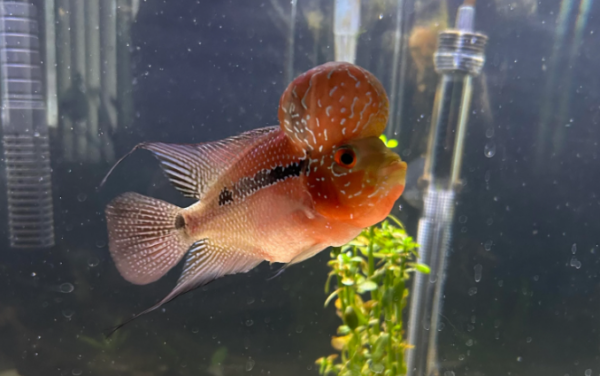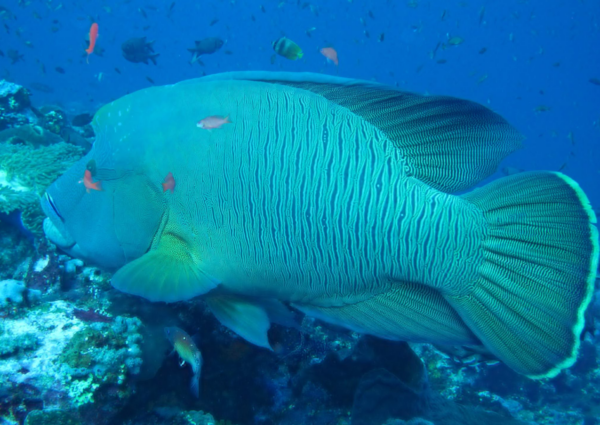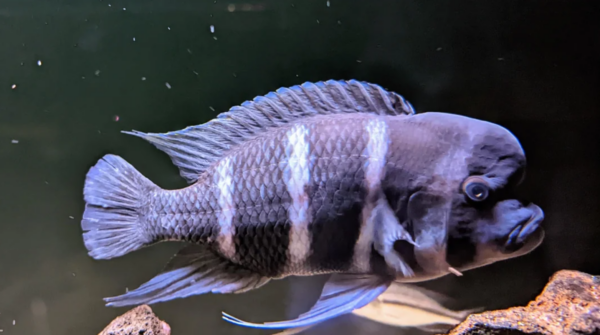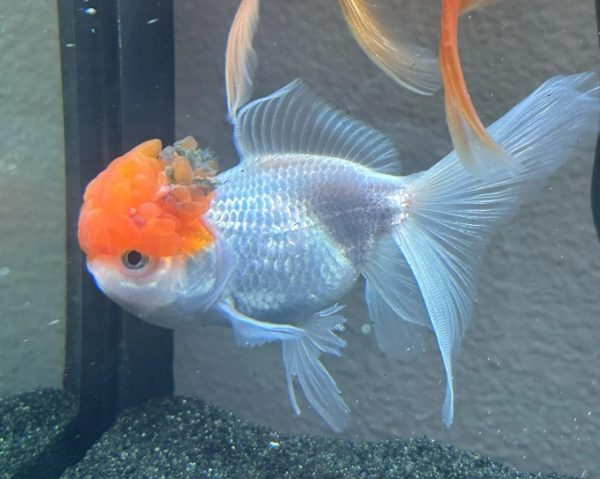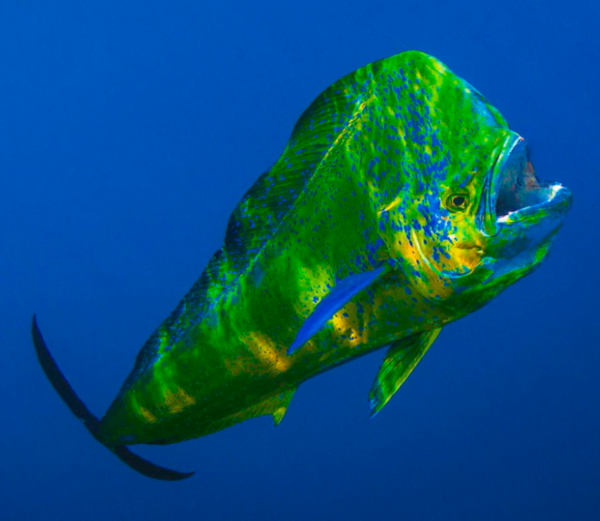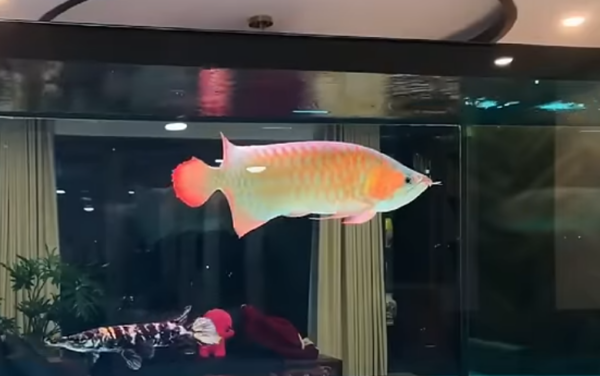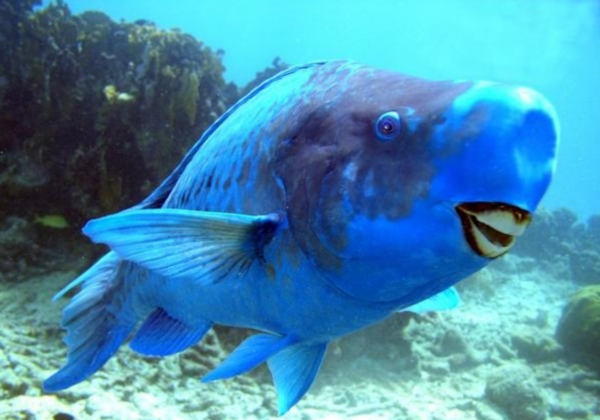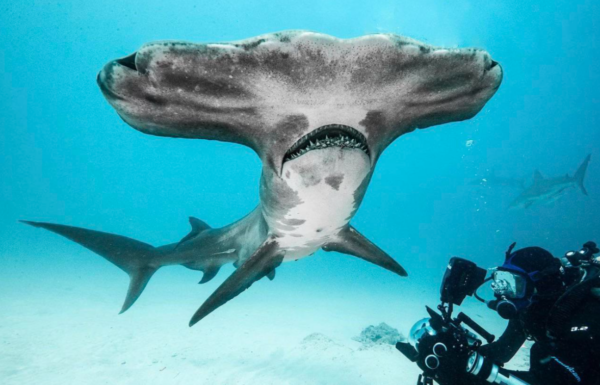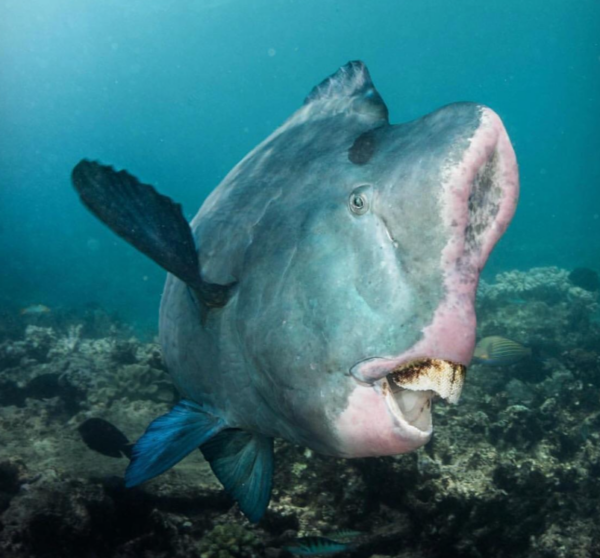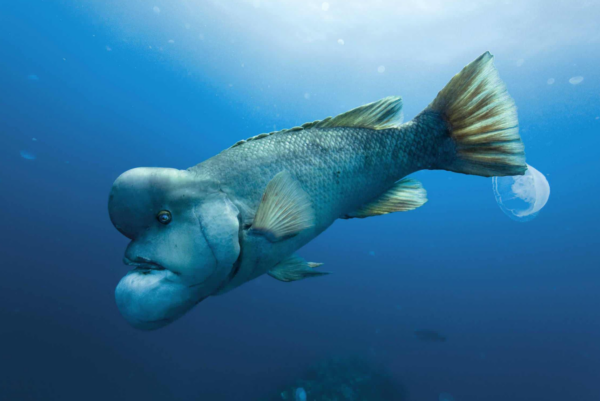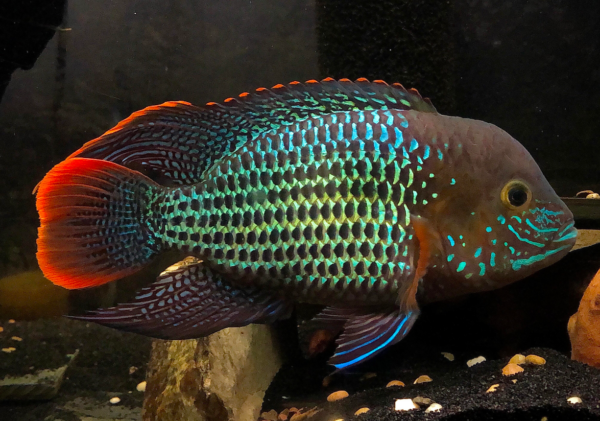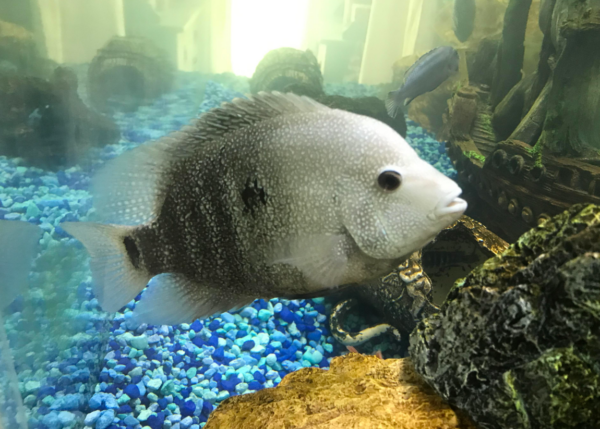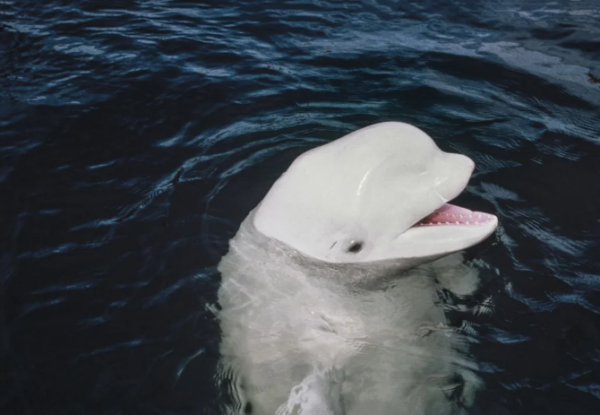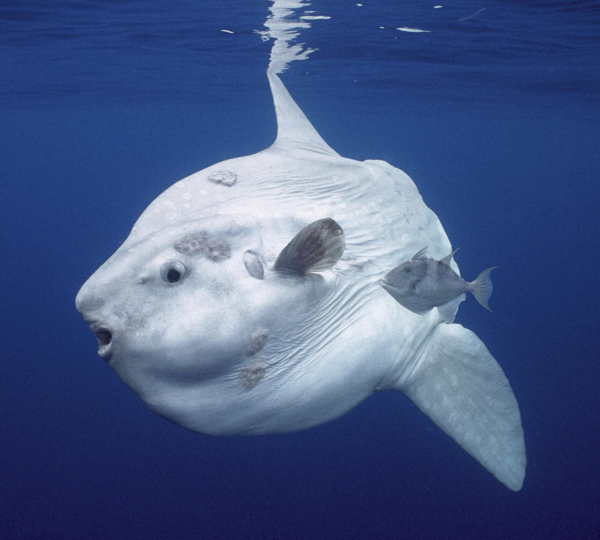We humans have a particular tendency to identify other creatures based on our biology. Unless they have spikes that look like hair on their head, fish theoretically don’t have foreheads. But, a few unique fish species have a larger head or a hump on the head that we refer to as a big forehead.
Naturally, big foreheads in fish species have distinctive benefits that help them adapt to their environment and offer a better chance of surviving.
- Gathering Food
Species like the Napoleon Wrasse and the Green Humphead Parrotfish have thick foreheads that act like battering rams. They use them to break apart coral for food or during territorial disputes.
- Social Displays
The prominent forehead bump (called a kok) on the Flowerhorn Cichlid is a display feature. The larger and brighter the kok, the more dominant and attractive the fish appears to potential mates.
- Echolocation
Seawater species such as dolphins and beluga whales use echolocation to navigate and hunt for prey. They emit sounds through their blowholes, which travel through the melon (fatty development on the forehead) and out into the water.
Here are a few fish species that have big foreheads. Some of these are aquarium-friendly; more are not.
Table of Contents
15 Fish With Big Forehead
1. Flowerhorn Cichlid
| Information Chart | Flowerhorn Cichlid |
| Scientific Name: | Amphilophus citrinellus hybrid |
| Family: | Cichlidae |
| Aquarium Safe | Yes |
| Care Level: | Intermediate to advanced |
| Temperament: | Aggressive towards their own and other species |
| Color: | Variety of colors and patterns |
| Lifespan: | 10 to 12 years |
| Size: | 10-12 inches |
| Diet: | Omnivorous, with a preference for meaty foods. |
| Minimum Tank Size: | 75 gallons for an individual |
| Temperature: | 78 to 82F |
| WaterConditions: | pH: 7.4 to 8.0 Moderately soft water |
| Tank Mate Compatibility | Best kept alone in a sufficient capacity tank |
Selectively bred from various Central American cichlids, the Flowerhorm cichlid is found in aquariums worldwide for its vibrant colors, intricate patterns, and unique shape. One of the most striking features of Flowerhorn Chichlids is their nuchal hump, a prominent growth on its head.
Frequently chasing away intruders, Flowerhorns are highly territorial in nature and have a natural curiosity towards their surroundings. They often identify and interact with their owners, showing remarkable intelligence and social behaviors.
Also Read: Sucker Fish: Care Tips, Tank Mates & More
2. Napoleon Wrasse
| Information Chart | Napoleon Wrasse |
| Scientific Name: | Cheilinus undulatus |
| Family: | Labridae |
| Aquarium Safe | Not recommended for home aquariums. Better suited to large public aquariums and specialized setups. |
| Care Level: | Expert |
| Temperament: | Generally peaceful |
| Color: | Vibrant bluish-green with dark spots on the dorsal fin. |
| Lifespan: | Over 30 years |
| Size: | Over 6 feet |
| Diet: | Carnivorous. Feeds on crustaceans, mollusks, and invertebrates. |
| Minimum Tank Size: | NA |
| Temperature: | 75 to 82F |
| WaterConditions: | Seawater Environment |
| Tank Mate Compatibility | NA |
Also known as Humphead Wrasse or Maori Wrasse, Napoleon Wrasse is a majestic fish primarily found in the waters and reefs of the Indo-Pacific regions with abundant hiding spots and crevices. Its elongated body, vibrant colors, and intricate markings adorn its prominent-most feature of the hump-like forehead.
Typically, Napoleon Wrasses are solitary and peaceful creatures. Except for the breeding times, when they often display a bit of temporary aggression towards competing males. The juvenile Wrasses often function as cleaning crews by removing parasites from the larger fish.
3. Frontosa
| Information Chart | Frontosa |
| Scientific Name: | Cyphotilapia frontosa |
| Family: | Cichlidae |
| Aquarium Safe | Yes |
| Care Level: | Intermediate |
| Temperament: | Relatively peaceful, can become territorial during breeding. |
| Color: | Blue-gray body with white or yellow stripes running vertically. |
| Lifespan: | 15 to 20 years with proper care |
| Size: | 11-13 inches |
| Diet: | Carnivorous. Feeds on small fish and crustaceans. |
| Minimum Tank Size: | Larger than 125 gallons for a small group |
| Temperature: | 75 to 80F |
| WaterConditions: | pH: 7.8 to 8.5Moderate water hardness |
| Tank Mate Compatibility | Thrives in a group and with other peaceful cichlids. |
Naturally found in the Northern part of Lake Tanganyika in Africa, Frontosa cichlids inhabit areas with rocky substrates and deep waters. Frontosa are characterized by their big hump-like forehead and prominent blue stripes along their body with beautifully white base coloration.
Frontosa cichlids are relatively peaceful and form small groups or schools to reduce anxiety and feel safe in their environment. However, they may get a bit aggressive during breeding seasons to maintain a hierarchical order based on dominance.
Also Read: Do Goldfish Have Teeth?
4. Redcap Oranda Goldfish
| Information Chart | Redcap Oranda Goldfish |
| Scientific Name: | Carassius auratus |
| Family: | Cyprinidae |
| Aquarium Safe | Yes |
| Care Level: | Beginner to intermediate |
| Temperament: | Very peaceful and social |
| Color: | Black, white, orange body with red-colored hood on the head. |
| Lifespan: | 10-15 years |
| Size: | 6 to 8 inches |
| Diet: | Omnivorous |
| Minimum Tank Size: | 20 gallons for a single oranda |
| Temperature: | 65 to 75F |
| WaterConditions: | pH: 6.5 to 7.5Soft water hardness |
| Tank Mate Compatibility | Other peaceful community fish |
Considered among the most popular aquarium fish, the Redcap Oranda Goldfish was selectively bred for centuries in China from wild carp species. True to its name, Redcap Orandas have a giant red cap on their head, known as a wen, resembling a big forehead. The growth often covers their eyes and makes it harder for the Orandas to move around.
In general, Redcap Orandas are well-loved for their charming and friendly demeanor. They’re social creatures who enjoy the company of other goldfish and form small groups within the aquarium. They also have an affinity for digging through the substrates in a burrowing-like behavior in search of food.
5. Mahi Mahi
| Information Chart | Mahi Mahi |
| Scientific Name: | Coryphaena hippurus |
| Family: | Coryphaenidae |
| Aquarium Safe | Not suitable for home aquariums due to their size, rapid growth rate, and specific care requirements. Some public aquariums have them. |
| Care Level: | Expert |
| Temperament: | Solitary. Sometimes found in small groups. |
| Color: | Iridescent blue-green and yellow bodies with vertical bars along their sides. |
| Lifespan: | 4 to 5 years |
| Size: | 4 to 5 feet |
| Diet: | Carnivorous. Feeds on fish, squids, and crustaceans. |
| Minimum Tank Size: | NA |
| Temperature: | 70 to 80F |
| WaterConditions: | Seawater |
| Tank Mate Compatibility | NA |
Commonly encountered in warm ocean water all over the world, including the Atlantic, Indian, and Pacific, Mahi Mahi prefers an offshore habitat near floating seaweed, debris, and buoys to hide and attract prey. Dazzling in glamorous green, blue, and gold, this oceanic fish has a blunt head and slender body for rapid swimming.
Mahi Mahi are highly migratory creatures and often travel in groups numbering in hundreds. They also are voracious predators and look for food in floating objects and debris. Anglers often target areas with submerged and floating objects when hunting for Mahi Mahi.
Also Read: 15 Fish With Big Lips – Photos & Facts
6. Aracana (Coffin Fish)
| Information Chart | Aracana (Coffin Fish) |
| Scientific Name: | Chaunax spp. |
| Family: | Chaunacidae |
| Aquarium Safe | Not suitable for home aquariums due to specialized care and relatively less known requirements. |
| Care Level: | Expert |
| Temperament: | Generally peaceful and solitary. Bottom-dwelling. |
| Color: | Brown or mottled in color. Blends in with their surroundings. |
| Lifespan: | Not well documented |
| Size: | Around 6 to 8 inches |
| Diet: | Carnivorous. Feeds on smaller fish, crustaceans, and invertebrates. |
| Minimum Tank Size: | NA |
| Temperature: | 50 to 60F |
| WaterConditions: | Seawater |
| Tank Mate Compatibility | NA |
Known as the sea toad, Coffin Fish is a popular fish found in deep-sea environments around the world. However, they’re mostly encountered on continental slopes and abyssal plains, where they inhabit muddy substrates and low-light conditions. Aracanas have a particularly eerie appearance with a bulbous head and a wide, gaping mouth.
Coffin fish are ambush predators. They emit bioluminescent light from their esca, a fixture on their head, to lure small fish and invertebrates. Aracanas are relatively slow swimmers and rely on their camouflage and stealth to capture prey.
7. Bluecheek Parrotfish
| Information Chart | Bluecheek Parrotfish |
| Scientific Name: | Scarus coeruleus |
| Family: | Scaridae |
| Aquarium Safe | Usually not kept in home aquariums due to larger size, specific care requirements, and aggressive behavior. |
| Care Level: | Advanced |
| Temperament: | Aggressive and territorial towards other fish. |
| Color: | Blue markings on their cheeks and greening body color. |
| Lifespan: | 10 to 20 years |
| Size: | 12 to 24 inches |
| Diet: | Herbivorous. Prefers an algae diet. |
| Minimum Tank Size: | NA |
| Temperature: | 75 to 82F |
| WaterConditions: | pH: 8.1 to 8.4 |
| Tank Mate Compatibility | Best kept alone |
Originating from the coral reef ecosystems of the Caribbean Sea and the western Atlantic Ocean, Bluecheek Parrotfish are commonly sighted, feeding on algae growing on the corals. Males of this species exhibit a more vibrant coloration with bluer, brighter cheeks and more complex patterns. Both sexes of the species change coloration as they mature.
One remarkable feature of Bluecheek Parrotfish is their method of sleeping. The fish secretes a mucous cocoon around its body to protect itself from predators and parasites. During the day, Bluecheeks are observed foraging the reefs in search of algae.
Also Read: White Mold In Aquarium, What Are They?
8. Bottlenose Dolphins
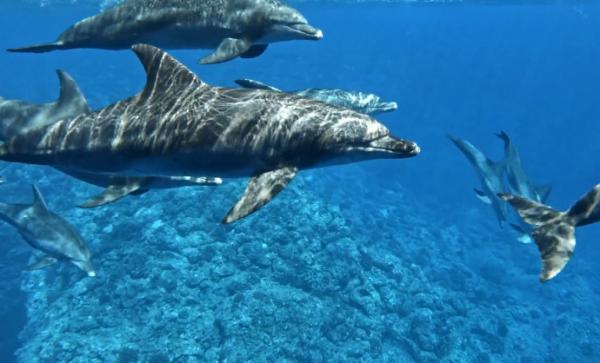
| Information Chart | Dolphins |
| Scientific Name: | Tursiops truncatus |
| Family: | Delphinidae |
| Aquarium Safe | No, even though they’re kept in marine parks for entertainment purposes. |
| Care Level: | Expert |
| Temperament: | Highly intelligent and social animals. Playful and acrobatic. |
| Color: | Gray in color with a white belly. |
| Lifespan: | 40 to 50 years |
| Size: | 6 to 13 feet |
| Diet: | Carnivorous. Feeds on fish, squid, and crustaceans. |
| Minimum Tank Size: | NA |
| Temperature: | Wide variation of temperatures |
| WaterConditions: | Saltwater environment |
| Tank Mate Compatibility | NA |
Commonly sighted in both coastal and offshore waters of the Atlantic, Pacific, and Indian oceans, Bottlenose Dolphins are renowned for their intelligence, agility, elongated snouts, and big foreheads called melons. Bottlenoses typically have a grayish-blue coloration with a whiter underbelly to avoid predation from below despite having only a few predators.
Bottlenose dolphins are highly social and interactive animals, living in groups called pods. These mammals engage in acrobatic displays, displaying affection, and refining group hunting skills. They also use their melons to locate prey through echolocation.
9. Hammerhead Shark
| Information Chart | Hammerhead Shark |
| Scientific Name: | Sphyrna mokarran |
| Family: | Sphyrnidae |
| Aquarium Safe | Not suitable for captive care. But some public aquaria have successfully kept them. . |
| Care Level: | Expert |
| Temperament: | Solitary predators. Found in small groups. |
| Color: | Grayish-brown coloration with lighter underside. |
| Lifespan: | 20 to 30 years |
| Size: | 10 to 20 feet |
| Diet: | Carnivorous. Feeds on fish, squids, rays, and crustaceans. |
| Minimum Tank Size: | NA |
| Temperature: | Found in various temperature regions worldwide |
| WaterConditions: | Seawater environment |
| Tank Mate Compatibility | NA |
Preferring warm waters yet tolerating cooler temperatures, the Hammerhead Sharks are found in oceans worldwide. The most striking feature of Hammerheads is their T-shaped flattened head containing a sensory organ known as ampullae of Lorenzini. It receives electrical signals transmitted by prey animals and helps it hunt also in murky waters.
Hammerheads migrate long distances in search of food, mates, and suitable habitat. During the mating season, males of the species engage in aggressive displays of mating rituals. However, they are generally not considered a threat to humans, even though they may investigate divers occasionally.
Also Read: South American Vs African Cichlids: Pros And Cons
10. Green Humphead Parrotfish
| Information Chart | Green Humphead Parrotfish |
| Scientific Name: | Bolbometopon muricatum |
| Family: | Labridae |
| Aquarium Safe | Not suitable for most home aquariums. |
| Care Level: | Advanced |
| Temperament: | Generally peaceful. Can become aggressive towards other fish if threatened. |
| Color: | Green in coloration with a bluish hue. |
| Lifespan: | Several decades under optimal conditions |
| Size: | 4 to 5 feet |
| Diet: | Omnivorous. Feeds on algae, coral polyps, and small invertebrates. |
| Minimum Tank Size: | NA |
| Temperature: | 75 to 82F |
| WaterConditions: | pH: 8.1 to 8.4Seawater environment |
| Tank Mate Compatibility | Other larger peaceful fish species. |
Native to coral reef environments throughout the tropical waters of the Indian and Pacific oceans, The Green Humphead Parrotfish or the Green Parrotfish plays a critical role in maintaining the coral reef ecosystem. Justifying their name, Green Parrotfish have a vibrant green coloration and distinctive head hump that develops further as they mature.
Green Parrotfish are omnivores, with a leniency towards feeding algae from the corals. Given the opportunity, they also feed on coral polyps and invertebrates. Their beak-like jaws are adapted to scraping algae and grinding away coral skeletons, which are later excreted as fine sand—promoting the natural process of reef formation and maintaining a healthy balance.
11. Asian sheepshead Wrasse
| Information Chart | Asian sheepshead Wrasse |
| Scientific Name: | Semicossyphus reticulatus |
| Family: | Labridae |
| Aquarium Safe | Not commonly kept at home aquariums. More suitable for larger public aquariums. |
| Care Level: | Advanced |
| Temperament: | Aggressive towards other fish with similar size and structure. |
| Color: | Dark brown or black with bright markings on their body. |
| Lifespan: | Several decades. |
| Size: | 3 feet |
| Diet: | Carnivorous. Feeds on crustaceans, mollusks, and small fish. |
| Minimum Tank Size: | NA |
| Temperature: | 72 to 78F |
| WaterConditions: | pH: 8.1 to 8.4 Seawater environment |
| Tank Mate Compatibility | Best kept alone or with other larger species. |
Found in rocky shores and coastal waters of the northwest Pacific Ocean, particularly in Japan, Korea, and China, Asian Sheepshead Wrasses prefer temperate climates but also are found in cooler waters with a strong current. The most unique features of Sheepshead are their big forehead and protruding lips that resemble a sheep or a goat—giving them a somewhat comical look.
They use their powerful jaws and teeth to crush and consume hard-shelled prey. During mating, males of Asian Sheepshead Wrasse undergo a dramatic change in coloration, with blue and greens becoming more pronounced and predominant.
Also Read: How To Take Proper Care Of Tropical Fish Babies (Fry)
12. Green Terror Cichlid
| Information Chart | Green Terror Cichlid |
| Scientific Name: | Andinoacara rivulatus |
| Family: | Cichlidae |
| Aquarium Safe | Intermediate |
| Care Level: | Yes |
| Temperament: | Territorial and aggressive in the tank. |
| Color: | Vibrant green and blue coloration with orange accents on their fins. |
| Lifespan: | 8 to 10 years |
| Size: | 8 to 10 inches |
| Diet: | Omnivorous. Mainly feeds on worms and small crustaceans.. |
| Minimum Tank Size: | 55 gallons for a single individual |
| Temperature: | 72 to 81F |
| WaterConditions: | pH 6.5 to 7.5 Soft to moderately hard water |
| Tank Mate Compatibility | Robust species capable of handling aggressiveness. |
Inhabiting slow-moving rivers and tributaries of the Amazon River basin in Peru and Ecuador, Green Terror Cichlids prefer environments with lots of hiding spots and sandy substrates. With a deadly combo of striking appearance and somewhat aggressive demeanor, Green Terror has a distinct hump-like forehead on its torpedo-shaped body.
Green Terror Cichlids are known to be territorial and aggressive toward other fish, especially while establishing dominance within a tank. However, they relax more when kept in a larger tank with lots of hiding spaces. Green Terrors are opportunistic feeders and prey on a variety of small fish and crustaceans in the wild.
13. Texas Cichlid
| Information Chart | Texas Cichlid |
| Scientific Name: | Herichthys cyanoguttatus |
| Family: | Cichlidae |
| Aquarium Safe | Yes |
| Care Level: | Intermediate |
| Temperament: | Territorial and aggressive |
| Color: | Various shades of blue, green, and orange. |
| Lifespan: | 8 to 10 years |
| Size: | 10 to 12 inches |
| Diet: | Omnivorous and accepts pellets, flakes, and frozen food. |
| Minimum Tank Size: | 55 gallons for a single Texas Cichlid |
| Temperature: | 72 to 82F |
| WaterConditions: | pH: 7.5 to 8.0Soft to moderate water hardness |
| Tank Mate Compatibility | Robust species that can handle occasional aggression. |
Native to the southern United States and northern Mexico, Texas cichlids are found in slow-moving rivers, streams, and reservoirs with sandy substrates. They prefer areas with dense vegetation and submerged roots where they have sufficient hiding spaces. Texas cichlids display iridescent green, blue, red, and yellow coloration with a relatively big forehead and mouth, contributing to their unique appearance.
This fish species is quite territorial and can be aggressive towards other fish in the tank, especially during breeding season when they show domiHow To Take Proper Care Of Tropical Fish Babies (Fry)nance to establish hierarchy. Texas cichlids feed on small fish, crustaceans, and invertebrates in the wild.
Also Read: 10 Reasons Why Your Fish Keep Dying
14. Beluga Whale
| Information Chart | Beluga Whale |
| Scientific Name: | Delphinapterus leucas |
| Family: | Monodontidae |
| Aquarium Safe | Not suitable to captive care. Best observed in accredited marine facilities. |
| Care Level: | NA |
| Temperament: | Highly social animals. Playful with humans. |
| Color: | White and light gray |
| Lifespan: | 35 to 50 years |
| Size: | 13 to 20 feet |
| Diet: | Carnivorous. Preys on small fish, squids, and octopus. |
| Minimum Tank Size: | NA |
| Temperature: | Adapted to live in icy conditions |
| WaterConditions: | NA |
| Tank Mate Compatibility | NA |
Primarily found in the Arctic Ocean and adjacent seas, Beluga Whales inhabit coastal areas and shallow bays. This remarkable marine mammal is well-adapted to life in the Arctic, possessing a thick layer of blubber and a big forehead to detect prey in the ice-covered regions through echolocation. They’re typically white or gray in coloration and lack a dorsal fin to easily navigate the icy surfaces.
Belugas are highly social animals, similar to dolphins. They live in pods and communicate using verbal signals, including clicks, whistles, and chirps. They emit high-frequency sounds to navigate and locate their prey in murky waters.
15. Ocean Sunfish
| Information Chart | Ocean Sunfish |
| Scientific Name: | Mola mola |
| Family: | Molidae |
| Aquarium Safe | Not suitable for captive care. Best observed in the wild. |
| Care Level: | NA |
| Temperament: | Solitary animals but often found in small groups. Slow-moving and docile. |
| Color: | Gray or brown in color with occasional pigmentation. |
| Lifespan: | Several decades. |
| Size: | 10 feet |
| Diet: | Primarily planktivorous. Occasionally feeds on jellyfish, salps, squids, etc. |
| Minimum Tank Size: | NA |
| Temperature: | NA |
| WaterConditions: | Seawater environment |
| Tank Mate Compatibility | NA |
Inhabiting oceans all over the world, Ocean Sunfish, aka mola mola, are the heaviest bony fish, with adults reaching up to 10 feet in length. Its flattened, disk-shaped body lacks prominent fins, limiting its maneuverability and making it rely on ocean currents for propulsion. Despite their cumbersome appearance, the rounder rudder-like tail fin allows them some form of agility in the water.
Ocean Sunfish are often found near the surface—sunbathing. It helps them regulate their body temperature and aid digestion. This species of fish is primarily solitary but forms loose groups during mating seasons.
Also Read: What’s The Weight Of A Gallon Of Water In Pounds And Kilograms?
The Bottom Line
We’ve compiled a list of 15 fish with big foreheads. Hope you found what you were looking for and have enjoyed reading the intriguing behaviors of the species.

